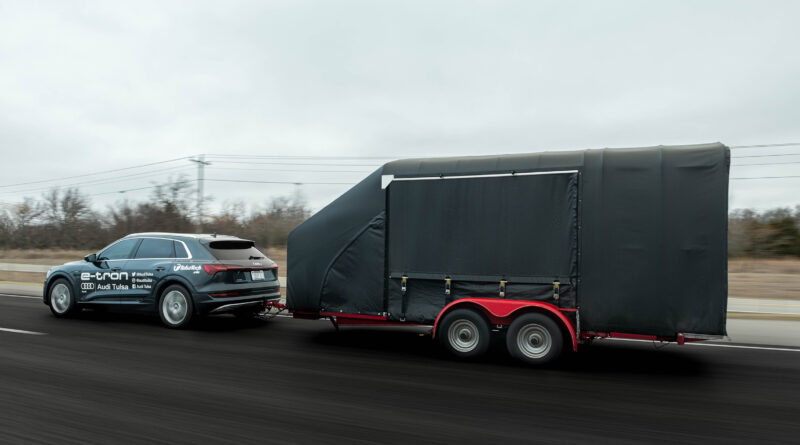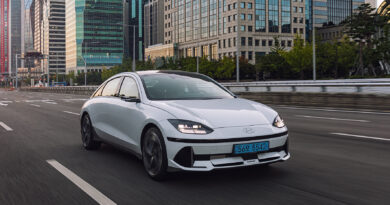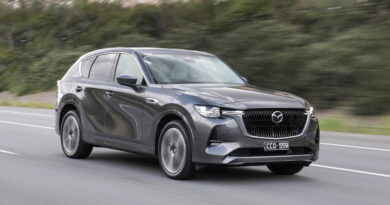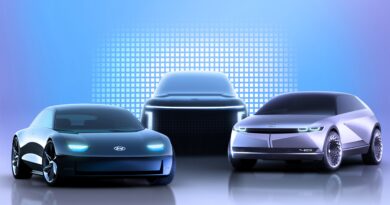Complete guide to towing with a hybrid, PHEV or EV
Australians love to tow.
Hit the roads during holiday times and there will be all manner of cars, SUVs and utes overflowing with push bikes, surfboards and dogs embarking on The Big Trip through the countryside, often with a sizeable caravan or boat in tow.
Combined with the big distances we often have to travel, that love of dragging big heavy things behind a big heavy vehicle is one of the reasons so many believe electric vehicles don’t currently make much sense for towing.
Want the latest EV news and reviews delivered to your inbox? Subscribe to our weekly newsletter!
So we thought we’d dive into the data to see if perceptions live up to reality.
READ MORE: Electric car advice and FAQ
TOWING VEHICLES: Every new electric ute promised or under development
EXCLUSIVE FEATURE: New EV calendar: all the electric cars and SUVs coming soon
Towing with a hybrid
Hybrids do their best fuel-saving work around town, where they can take advantage of regenerative braking that converts energy normally lost in heat in the brake system back into electricity.
They’ll very quickly empty and recharge the batteries as the car builds speed and slows down.
It’s a carefully choreographed dance between electricity and an internal combustion engine that can reduce fuel use by 50 percent – or more.
So, how does a hybrid go towing?
The battery pack on regular hybrids tends to be tiny. On a Toyota Yaris Cross, for example, it’s around 0.76kWh while on a RAV4 Hybrid it’s about 1.6kWh. Compare that with the 40-100kWh battery packs on full EVs and it’s clearly the petrol doing most of the work in a regular hybrid.
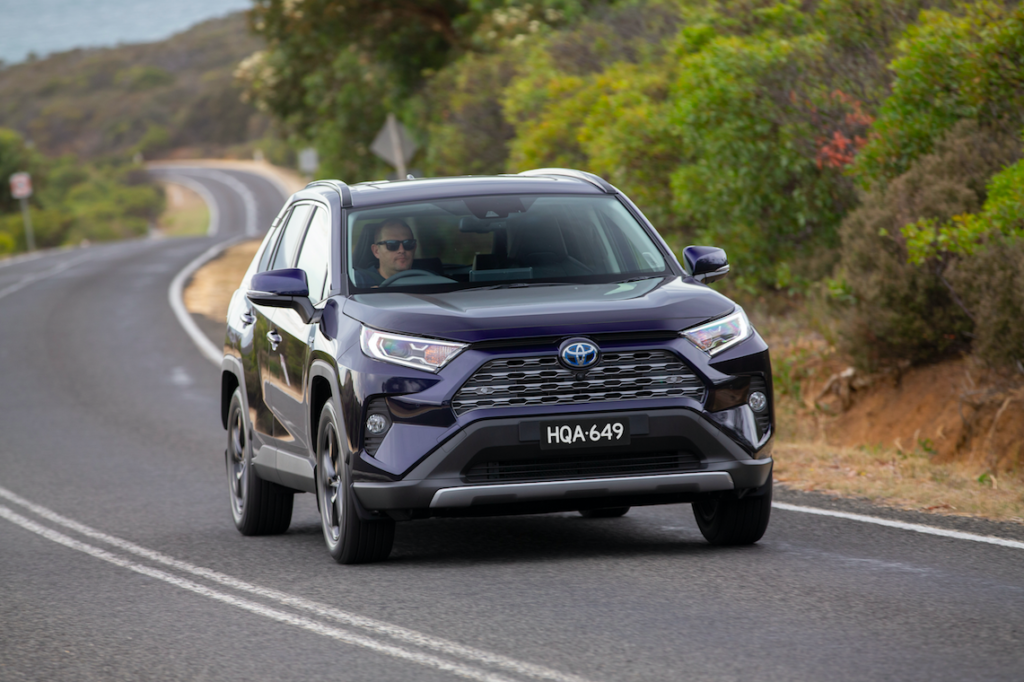
Little wonder most hybrids are lucky to go a few hundred metres without the help of their petrol engine.
When towing, the engine will work harder and the battery pack will drain quicker. The benefits compared with an ICE car are likely to be less obvious.
But they can tow. A RAV4 Hybrid, for example, is rated to tow 480kg as a two-wheel drive model (enough for, maybe, a small box trailer) or 1500kg with the AWD system that adds another electric motor to the rear wheels. That’ll help with small caravans or boats.
Towing with a plug-in hybrid
Plug-in hybrids are a different story, mainly because they have larger battery packs generally designed to take them 35-60km on electricity alone.
When towing you can expect a significantly reduced electric range, although how much depends on what you’re towing and how fast you’re going. The faster you drive, the more aerodynamic drag you create, which can reduce the range.
Obviously with a PHEV you can run them purely on petrol, so there are no issues with keeping on motoring.
But expect to use many multiples of the claimed fuel use of the PHEV, a figure kept artificially low due to the testing procedure stipulated by the Australian Government and how it relates to cars that can run partially on electricity.
The Mitsubishi Outlander PHEV has a claimed fuel use of 1.9 litres per 100km. You’ll typically use either no fuel (when running only on electricity) or about four times that amount. When towing close to the 1500kg rated maximum you could expect to slurp fuel at well into double digits.
It’s also likely a PHEV will use more than an equivalent diesel-powered SUV (diesel has long been the preferred fuel choice for towing), obviously depending on what and how you’re towing.
And in some instances the PHEV version may have a lower rated tow capacity. With the Mercedes-Benz GLC, for example, the GLC300e plug-in is rated at 2000kg, while the GLC300 petrol-only model is at 2400kg.
While some PHEVs tow less than their ICE equivalent, others don’t. You can still have very high tow capacities for PHEVs.
See our list of the top selling PHEVs of 2020.
The Porsche Cayenne E-Hybrid, for example, is rated to tow up to 3.5 tonnes – the same as a Toyota LandCruiser – and the Range Rover PHEV can take 2.5 tonnes.
However, the Range Rover PHEV is a heavy car that already doesn’t take much right-foot enthusiasm to revert to its four-cylinder engine for added muscle, so once towing anything close to that 2500kg you can guarantee a lot of the work will be done by the engine.
Volvo’s PHEVs tow between 1800kg and 2400kg and the BMW X5 xDrive 40e up to 2700kg, the latter identical to other X5s.
But whereas many PHEVs do a good job of relying solely on electricity for average driving duties, you’ll almost certainly be using the engine almost all the time when towing big loads like that.
| Make and model (hybrid and PHEV) | Tow capacity |
| BMW 530e | 750kg |
| BMW X5 xDrive 40e | 2700kg |
| Hyundai Ioniq Hybrid | 800kg |
| Hyundai Ioniq Plug-in Hybrid | 750kg |
| Mercedes-Benz GLC300e | 2000kg |
| Mini Countryman PHEV | Not rated to tow |
| Mitsubishi Outlander PHEV | 1500kg |
| Porsche Cayenne E-Hybrid | 3500kg |
| Porsche Cayenne Turbo S E-Hybrid | 3000kg |
| Range Rover/Range Rover Sport PHEV | 2500kg |
| Toyota RAV4 Hybrid | 480kg (2WD), 1500kg (AWD) |
| Volvo XC40 Recharge PHEV | 1800kg |
| Volvo XC60 T8 PHEV | 2100kg |
| Volvo XC90 Recharge PHEV | 2400kg |
Towing with an EV
Listen to our coal-loving Prime Minister and EV sceptics and they’ll tell you electric motors aren’t up to the task of lugging a big load.
There are plenty of trains and trams running around the country that would suggest otherwise.
For a publicity stunt in 2019 the diminutive Mini Electric towed a Boeing 777 cargo plane weighing about 150 tonnes. So, clearly it can be done!
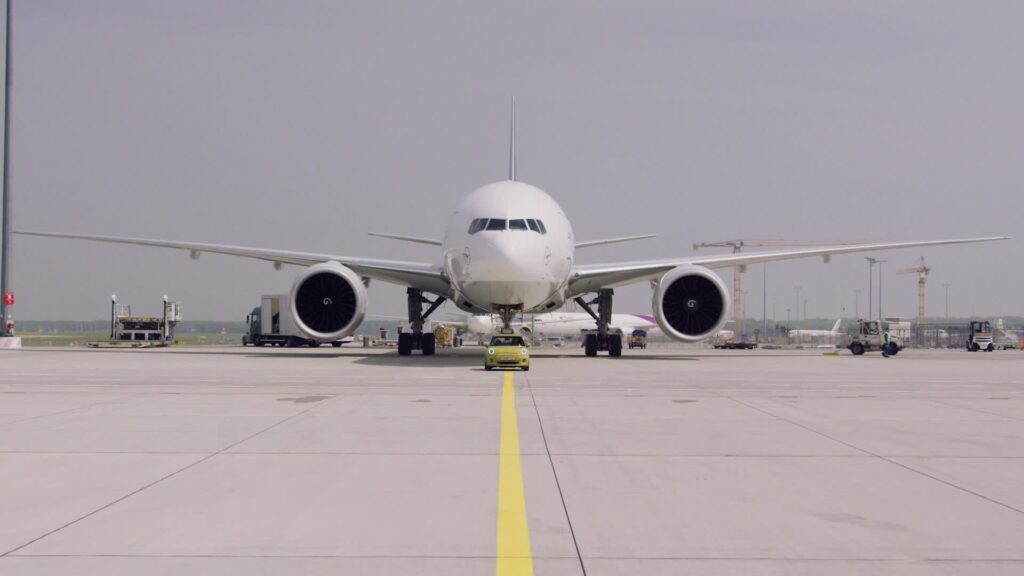
Like most electric cars currently on sale in Australia the Mini Electric isn’t rated to tow, so can’t do so legally.
However, it was evidence that electric motors are perfectly suited to carrying big loads, with lashings of torque that makes moving things easier.
See our list of the top selling EVs of 2020.
The issue with EVs towing tends to be the batteries.
Battery packs are heavy and expensive and with the current tech take longer to charge than a petrol car does to refuel
The quantity of batteries required to tow a boat or horse float or caravan would need to be very big and/or charged regularly.
In 2020 Audi conducted an experiment in the US to show off the tow capacity of its e-Tron mid-sized SUV.
It travelled 811km carrying the maximum 1800kg in a trailer. The trip was done in mostly cold and rainy conditions (cold weather, in particular, reduces the range of an EV) at an average speed of 97km/h.
Electricity consumption was logged at almost 48kWh per 100km, which is about double the regular electricity consumption for an e-Tron.
Using the larger 95kWh battery pack in the e-Tron 55 that would reduce the range to about 200km.
For most people that’s obviously going to create serious limitations and make the family holiday a tad less than ideal.
However, with rapidly improving battery technology and more ultra-rapid charging stations popping up on major routes the equation is only going to improve over time.
And the e-Tron’s impressive torque clearly didn’t have any issues shifting a big load.
While some EVs aren’t rated to tow – the Renault Zoe, BMW i3, Nissan Leaf, Mazda MX-30 Electric, Hyundai Kona Electric, Hyundai Ioniq Electric and Tesla Model S are among them – some are.
The Tesla Model X SUV can tow up to 2250kg and the Jaguar I-Pace can take 750kg, while the newly arrived Polestar 2 and its EV twin-under-the-skin, the Volvo XC40 Pure Electric, are each rated to tow 1500kg. However, it’s worth checking the owner’s manual for other conditions and recommendations; with the Model X, for example, Tesla suggests using a trailer braking system for all trailer loads over 450kg (Australian regulations allow unbraked trailers up to 750kg).
The arrival of the heavily updated Tesla Model 3 early in 2024 brought with it the ability to tow. Previously the Model 3 was not certified to tow in Australia, but the new one can lug up to 750kg.
While the Mercedes-Benz EQC is rated to tow 1800kg overseas, it hasn’t been certified to tow in Australia. Mercedes-Benz says the unique hardware required to tow in Australia (our tow hitches are different to the ones used in Europe and often require a higher towball download rating) and lack of demand means it hasn’t bothered with a tow setup for now.
One tech that is arguably better suited to towing once the refueling architecture is in place to support it is fuel cell electric vehicles (FCEV). Toyota is one that sees potential for FCEVs for towing.
| Make and model: EVs and FCEVs | Tow capacity |
| Audi Q8 e-Tron | 1800kg |
| Audi e-Tron GT | Not rated to tow |
| BMW iX1 | 1200kg |
| BMW i4 | 1600kg |
| BMW iX3 | 750kg |
| BMW iX | 2500kg |
| BMW i7 | 2000kg |
| BYD Dolphin | Not rated to tow |
| BYD Atto 3 | 750kg |
| BYD Seal | Not rated to tow |
| Genesis GV60 | Not rated to tow |
| Genesis Electrified EV70 | 1800kg |
| Genesis Electrified G80 | Not rated to tow |
| GWM Ora | Not rated to tow |
| Hyundai Kona Electric (Extended Range only) | 750kg |
| Hyundai Ioniq 5 (Extended Range only) | 1600kg |
| Hyundai Ioniq 6 | |
| Hyundai Nexo | Not rated to tow |
| Jaguar I-Pace | 750kg |
| Kia Niro Electric | 750kg |
| Kia EV6 | 1600kg |
| Kia EV6 GT | 1800kg |
| LDV eT60 | 1000kg |
| Lexus UX300e | Not rated to tow |
| Mazda MX-30 E35 Astina | Not rated to tow |
| Mercedes-Benz EQA | Not rated to tow |
| Mercedes-Benz EQB | Not rated to tow |
| Mercedes-Benz EQE | |
| Mercedes-Benz EQE SUV | 1800kg |
| Mercedes-Benz EQS | |
| Mercedes-Benz EQS SUV | 1800kg |
| MG4 | 500kg |
| MG ZS EV | 500kg |
| Mini Electric | Not rated to tow |
| Nissan Leaf and Leaf e+ | Not rated to tow |
| Polestar 2 | 1500kg |
| Porsche Taycan | Not rated to tow |
| Porsche Taycan Cross Turismo | Not rated to tow |
| Tesla Model 3 | 750kg |
| Tesla Model Y | 1600kg |
| Tesla Model S | Not rated to tow |
| Tesla Model X | 2250kg |
| Toyota Mirai | Not rated to tow |
| Volvo XC40 Pure Electric | 1500kg (single motor), 1800kg (dual motor) |
| Volvo C40 | 1500kg (single motor), 1800kg (dual motor) |
*1800kg tow capacity globally but the EQC hasn’t been certified for towing in Australia
** Tesla has certified the Model 3 to tow up to 1000kg but the owner’s manual stipulates the car is not capable of towing
Powered trailers a solution for the future
Technology and innovative thinking could also make towing with an EV easier in future.
German company Dethleffs is already working on technology that integrates batteries and electric motors into the trailer.
READ MORE: The EV towing solution: Port up your caravan
The idea is that the caravan can provide its own energy supply and propulsion.
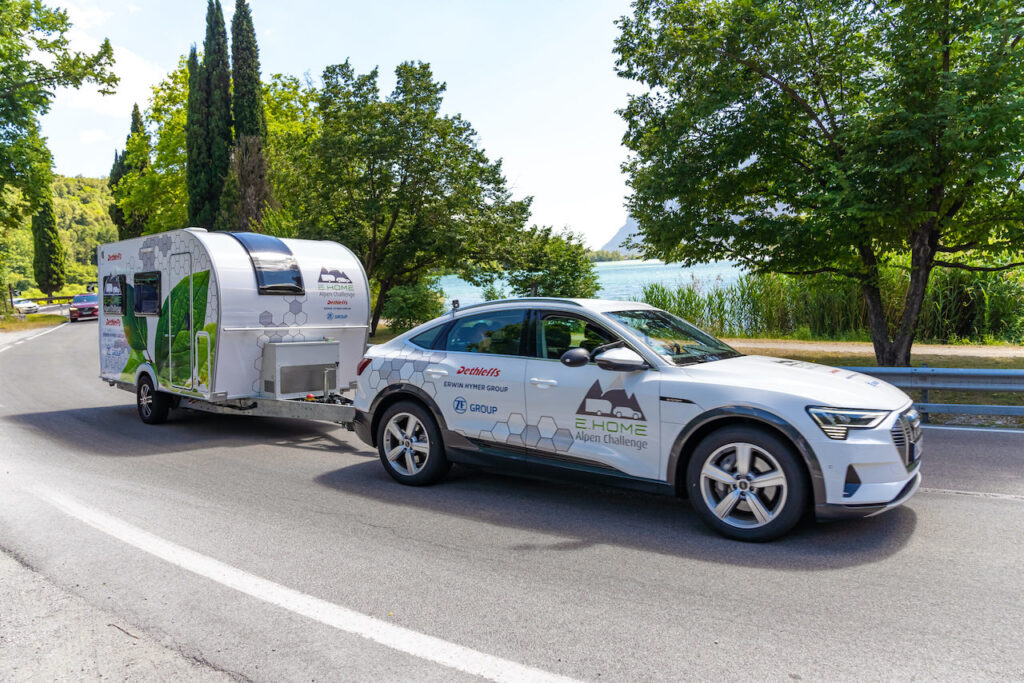
That means the tow vehicle would provide similar performance to what it normally does when it’s not towing and be able to travel similar distances as it would if it were not towing.
There’s still work to go until the technology is available to buy – and, of course, there’s the issue of how much it will cost.
But it’s an idea of how manufacturers are thinking when it comes to towing with an EV.

